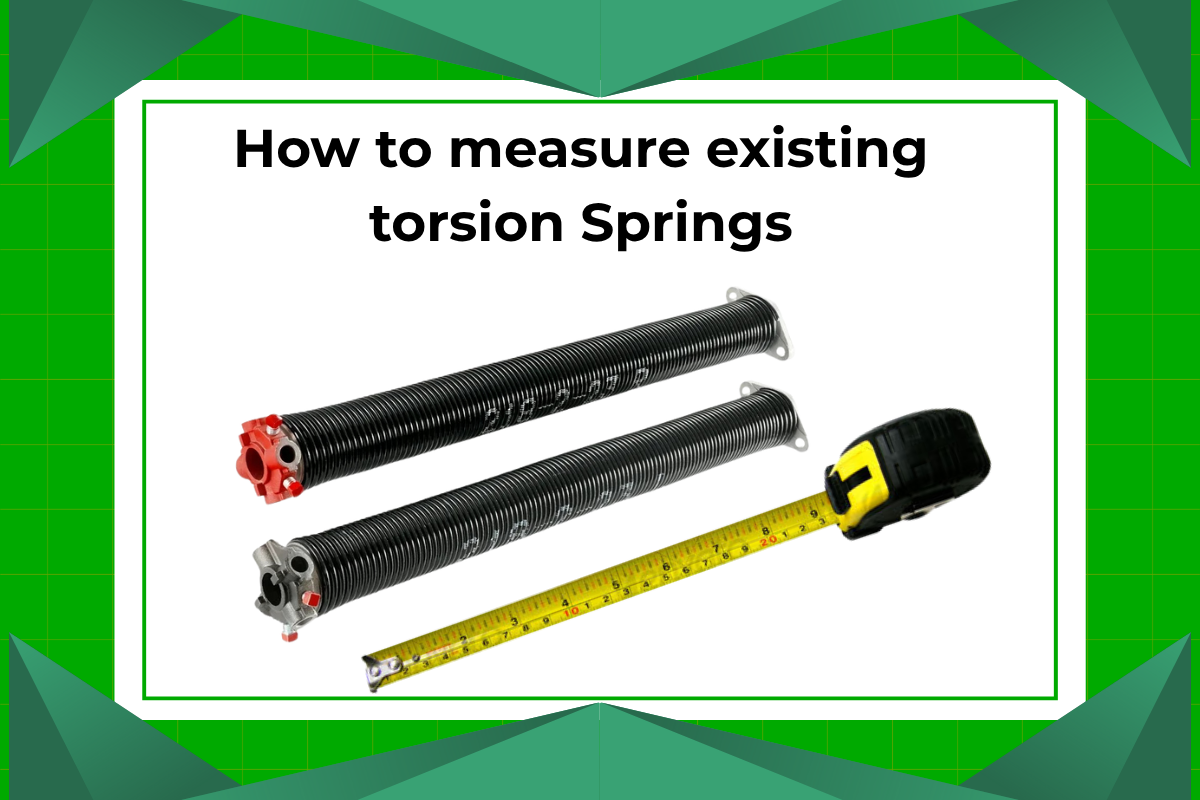How to Select the Correct Torsion Spring
(Please read the instructions below completely before placing an order)
IMPORTANT: If the replacement spring is not selected and installed accurately (based on proper measurements), it may not function correctly and could damage the door or the motor. Our qualified technicians are available if you have any questions before ordering or if you need assistance measuring.
1. Find the Wire Size
-
Measure the length of 10 coils of your torsion spring using a tape measure.
-
Refer to the chart below to locate the corresponding wire size. For extra accuracy, measure 20 coils and verify that both measurements correspond to the same wire size. If they don’t match, measure again in a different portion of the spring. Ensure that there are no gaps between coils when measuring; gaps will result in incorrect measurement.
| 10-Coil Measurement (inches) | Centimeters | 20-Coil Measurement | Centimeters | Wire Size (inches) |
|---|---|---|---|---|
| 1-3/4″ | 4.5 cm | 3-1/2″ | 8.99 cm | 0.177″ |
| 1-7/8″ | 4.76 cm | 3-3/4″ | 9.53 cm | 0.187″ |
| 1-15/16″ | 4.88 cm | 3-7/8″ | 9.75 cm | 0.192″ |
| 2″ | 5.08 cm | 4″ | 10.16 cm | 0.200″ |
| 2-1/16″ | 5.26 cm | 4-1/8″ | 10.52 cm | 0.207″ |
| 2-3/16″ | 5.55 cm | 4-3/8″ | 11.11 cm | 0.218″ |
| 2-1/4″ | 5.72 cm | 4-1/2″ | 11.45 cm | 0.225″ |
| 2-5/16″ | 5.95 cm | 4-5/8″ | 11.90 cm | 0.234″ |
| 2-7/16″ | 6.19 cm | 4-7/8″ | 12.38 cm | 0.243″ |
| 2-1/2″ | 6.35 cm | 5″ | 12.70 cm | 0.250″ |
| 2-5/8″ | 6.67 cm | 5-1/4″ | 13.34 cm | 0.262″ |
| 2-3/4″ | 6.93 cm | 5-1/2″ | 13.87 cm | 0.273″ |
| 2-13/16″ | 7.19 cm | 5-5/8″ | 14.38 cm | 0.283″ |
Note: This is a commonly used wire-size chart.

(Photo: Example of measuring 20 Coils)
2. Find the Spring Inside Diameter (I.D.)
Measure the inside diameter of the coil from the side view (measuring across the hollow center of the spring) without including the end cones.
Alternatively, you can measure the outside diameter (O.D.) then subtract twice the wire size.
Example: O.D. = 2.414″ – (wire size 0.207″ × 2) = I.D. ≈ 2.000″.
Also, many cones have manufacturing stampings which indicate the I.D.: for example, “P200” or “P2000” may indicate a 2.0″ I.D., and “P175” may indicate a 1 ¾″ I.D. Most residential torsion springs use 1 ¾″ or 2″ I.D. (though some brands like Raynor use 2¼″ ID).
For heavier or commercial doors, it may be common for the spring to utilized a larger inside diameter such as 2-5/8", 3-3/8" or 3-3/4"

(Photo: Inside vs Outside Diameter)
3. Find the Spring Length
To measure the length accurately, ensure the spring is in its unwound (relaxed) state—otherwise the measurement will be off by several inches.
-
If the spring is still intact and attached: Measure from end to end of the spring coils only — do not include the stationary and winding cones.
-
If the spring is broken (in two or more pieces): Lay the pieces end-to-end and measure each coil section; then add those together to get the total length.

(Photo: Measuring the overall length without the cones)
4. Confirm Wind Direction
If you have a single-spring system, you’ll need to know whether it is left-wound or right-wound (RHW/LHW). For a two-spring system, typically the left spring is RHW, and the right spring is LHW (as viewed from inside the garage looking out). Often times there may be spray paint or a color marking on the winding cones that may assist in identifying the wind of the spring.

(Photo: Left vs Right Wound Spring standing from inside of the garage)

(Photo: Left vs right wound cones color marking)
Note: This is standard for most garage doors with the springs mounted on the center of the garage door.
5. Why Accurate Measurement Matters
-
Using a spring with the wrong wire size (gauge) or I.D. may result in insufficient or excessive lifting force — which can damage the door, the opener, or create unsafe conditions.
-
Measuring while the spring is wound, under tension, or while the door is not in the closed, relaxed state will produce inaccurate lengths.
-
Most standard residential torsion springs are rated for ~10,000 cycles (each open/close count as one cycle). If your application is heavy-use, you may want a higher-cycle spring.
6. Additional Parts & Services
We carry many other repair and replacement parts for overhead garage door systems from all major brands. Some parts are still being listed — please send us a message if you’re looking for something you don’t see.
7. Safety & Disclaimer
⚠️ CAUTION: Installing or repairing a garage door is a dangerous task. Garage door torsion springs and cables are under extreme tension and can cause serious injury or death if handled improperly. We strongly recommend that all installation, repair, adjustment, and removal of garage doors and openers be performed by a qualified garage-door technician. Any attempt to install, repair, replace, or adjust a garage door or opener is done at your own risk. In no event shall My Garage Door Parts (or its affiliates) be liable for any damages, personal injury, or death. By purchasing our products, you agree to these terms and assume all responsibility and risk for use of the information and products purchased.
If you still need additional assistant, please give us a contact found here: Contact My Garage Door Parts | Spring, TX | Expert Support & Parts Assistance
We are here to help!

